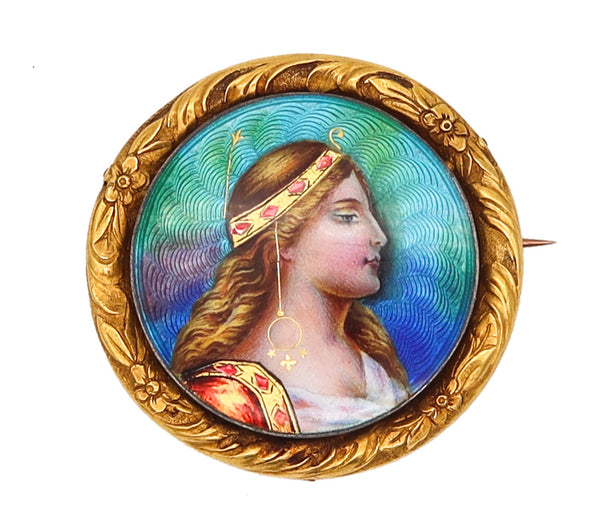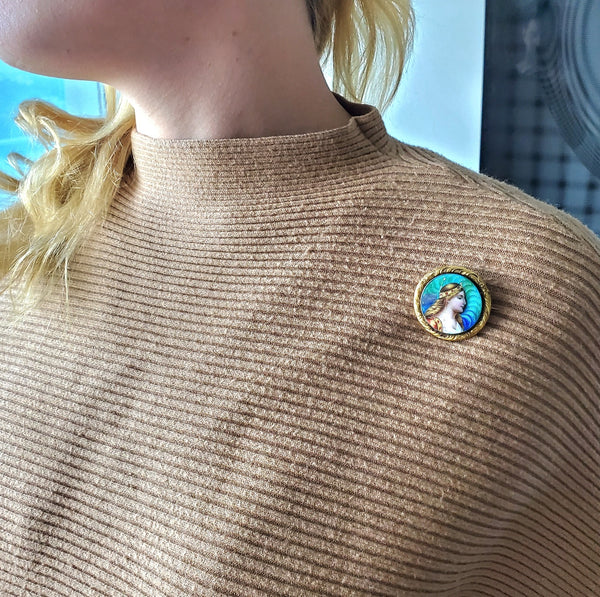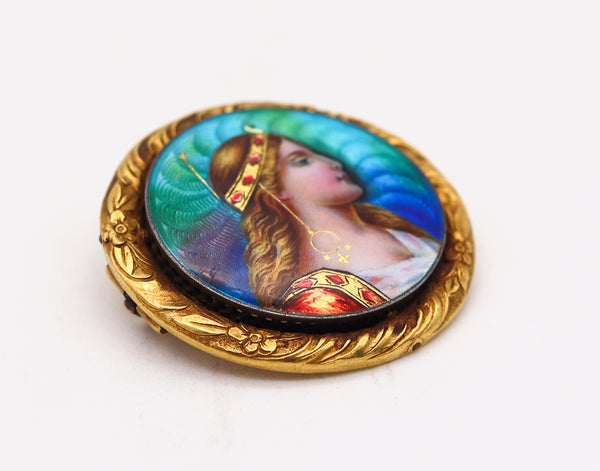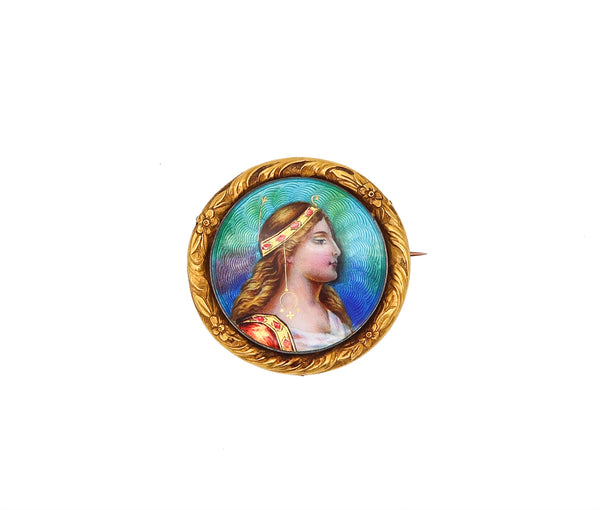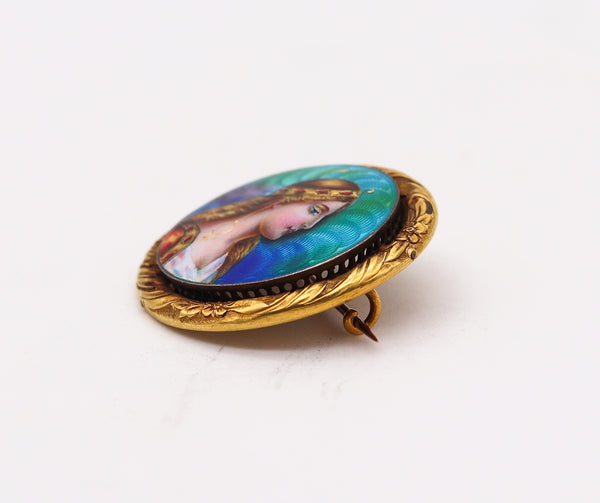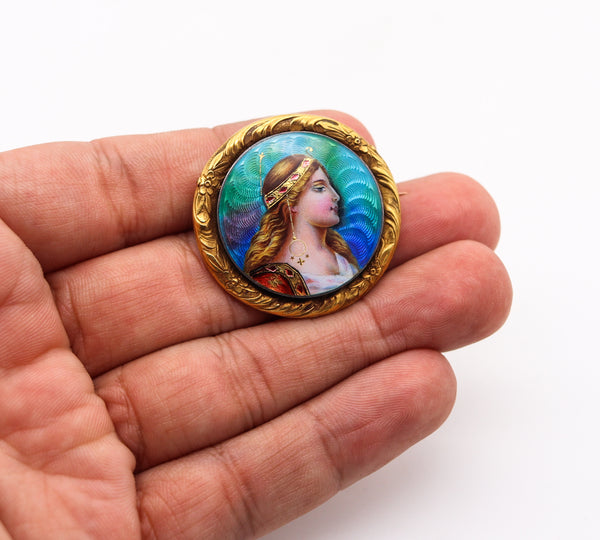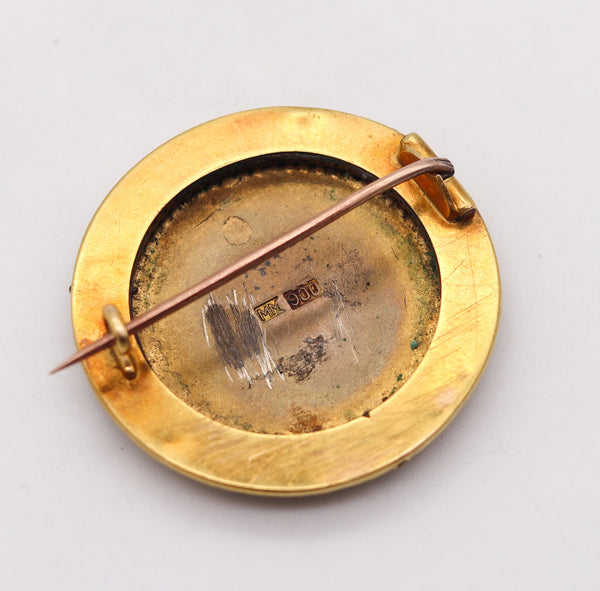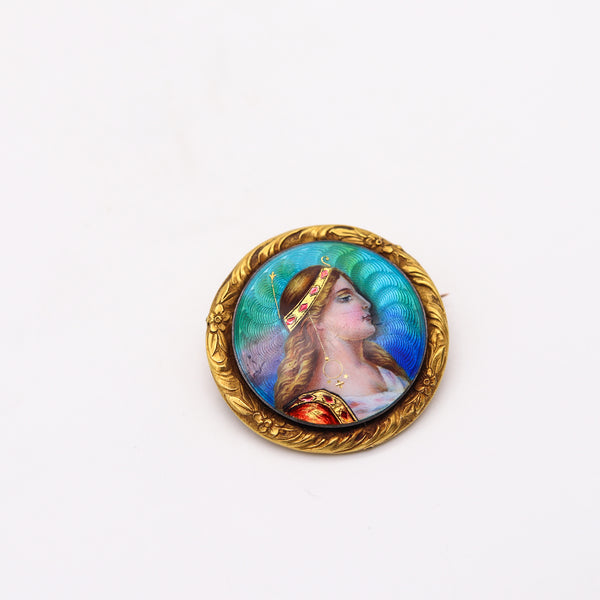Meyle Mayer Pforzheim 1895 German Art Nouveau Enamel Brooch In 18Kt Gold With Portrait Of Diana
An etruscan revival enameled brooch designed by Meyle & Mayere.
Magnificent antique piece, created in Pforzheim Germany by the jewelry maker's Meyle & Mayer, in the late 19th century, circa 1895. This brooch has been crafted with Etruscan revival patterns, in solid yellow gold of 18 karats. It is fitted at the reverse with a hinged horizontal pin bar with a security hook lock to wear as a brooch (can be wear in a chain too). The central panel is carefully made in .900 silver and decorated with vibrant vivid multicolor polychrome enamels over a guilloche surface, depicting the portrait of an ancient Etruscan queen facing to the right.
The queen's portrait is richly dressed with colorful Elizabethan ropes, wearing gold jewelry; a drop dangle earrings and a diadem crown. The crown is excessively well decorated similar to the ancient mythological image of the goddess Diana for the Greeks or Artemis for the Romans.
Weight: 13.55 Grams, (8.68 Dwt).
Measurements: A diameter of 36 mm (1.41 Inches).
Hallmarks: Stamped with with the maker's mark associated to Meyle & Mayer, the gold assay mark and signed, "MM .900 18ct".
Meyle & Mayer
The company was founded in 1887 in Pforzheim, Germany by Gustave Mayle and Julius Mayer. They were two of the greatest Jugendstil / Art Nouveau masters in Germany, who produced rich and astounding jewelery. The Meyle & Mayer manufacture was destroyed during WW2 (in 1945) and never operated again.
History: Between the 1820 and 1890, ancient cities were discovered, such as Troy, Pompeii and Alexandria. Archaeological excavations in Egypt, Greece and Rome, discovered artistic pieces of these ancient cultures. These fabulous discoveries, stimulated cultural trips to these countries, popularly called "grand tour". Being the case that the enthusiast visitors bring back small objects, like souvenirs to be assembled into jewelry. The starting point of these trips were in the cities of Rome and Venice. this is why the craftsmen of these cities created small and interesting objects with ancient characteristics like this cameo.
Revival jewelry: The styles from the renaissance and Middle Ages, begun in the 1850’s, The Renaissance and Egyptian revivals were joined by a classical revival of Greek and Etruscan styles to conform a new aesthetic. As a result of the construction work on the Suez Canal in the mid-1860’s and the Egyptian excavations of Auguste Mariette and the resultant exhibit of Egyptian treasures at the exposition Universelle in 1867, a fascination for all things Egyptian and ancient cultures developed.
Note: Many nineteenth-century jewelers, the most famous being the House of Castellani, were inspired to create their own versions of these ancient pieces, hence “Etruscan Revival.” Characteristics of Etruscan style jewelry include use of high karat gold and semi-precious stones like lapis, malachite and agates, and most distinguishingly, the use of intricate filigree and granulation.
Note: Guilloché is used in fine jewelry to enhance the appearance of brooches, rings and pendants. Guilloché enamel refers to metal pieces that have been given the Guilloché treatment and then covered with a translucent layer of enamel, giving the geometric patterns underneath the enamel a colorful hue.
Literature: Jugendstil-Schmuck // Art Nouveau Jewellery from Pforzheim, Fritz Falk, 2009, for similar pieces illustrated.
Collateral: It is accompanied by a presentation jewelry box.
Condition: The condition of this piece is very good. Beside the little normal wear, there is no damage to the gold just normal scratches in the back. This brooch has been carefully inspected to guarantee the condition and authenticity.
INVENTORY REF: P112122MONM/.3257









